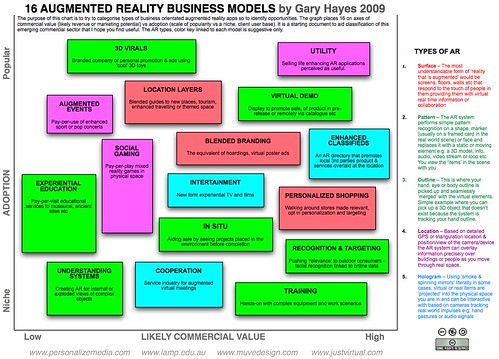A great article by Gary Hayes that gives a good overview of the current categorisation of the Augmented Reality apps and the potential for business adaptation. There are lots of AR video in the complete post, plus a longer explanation of each model. You can also link to Flickr for a larger version of the AR Business Models chart. I leaned a great deal of it and gave my musings on AR more structure so want to share it with you.
Some excerpts:
But before going onto my list (which is of course non-exhaustive) here are the basic types of Augmented Reality from a slightly technical perspective but which we can apply to commercial and marketing applications. My presentations and paper have much more detail with specific case studies of each.
- Surface – The most understandable form of ‘reality that is augmented’ would be screens, floors, walls etc that respond to the touch of people in them providing them with virtual real time information or collaboration
- Pattern – The AR system performs simple pattern recognition on a shape, marker (usually on a framed card in the real world scene) or face and replaces it with a static or moving element e.g: a 3D model, info, audio, video stream or loop etc: You view the ‘items’ in the scene with you
- Outline – This is where your hand, eye or body outline is picked up and seamlessly ‘merged’ with the virtual elements. Simple example where you can pick up a 3D object that doesn’t exist because the system is tracking your hand outline.
- Location – Based on detailed GPS or triangulation location & position/view of the camera/device the AR system can overlay information precisely over buildings or people as you move through real space.
- Hologram – Using ‘smoke & spinning mirrors’ literally in some cases, virtual or real items are ‘projected’ into the physical space you are in and can be interactive with based on cameras tracking real world impulses e.g: hand gestures or audio signals
Before the more detailed list I embed my summary flickr chart whose purpose is to try to categorise types of business orientated augmented reality apps so to identify opportunities. The graph places 16 on axes of commercial value (likely revenue or marketing potential) vs adoption (scale of popularity vs a niche, client user base). It is a starting document to aid classification of this emerging commercial sector that I hope you find useful. The AR types, color key linked to each model is suggestive only. (Click on image for enlargement over at my flickr pages)

Leave a Reply